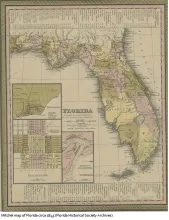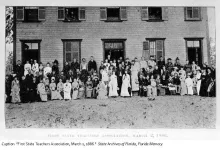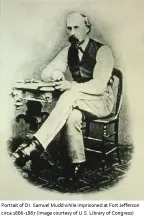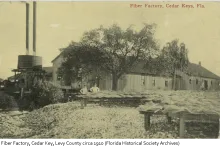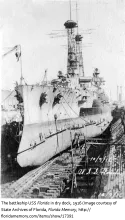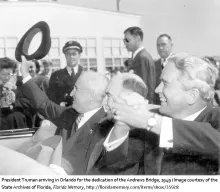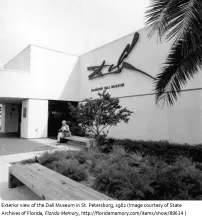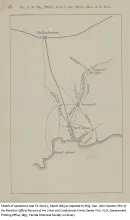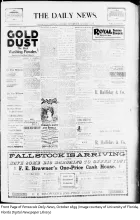1845 – Florida is admitted into the United States as the 27th state on this date! After centuries of Spanish rule, 20 years of British control, and almost 25 years as a U.S. territory, Florida was finally voted in as a state. President John Tyler signed the admission bill. Floridians had voted in a referendum in favor of statehood in 1838 and a state constitution was approved in 1839, but it was not until the U.S. Congress approved the act in 1845 admitting both Florida and Iowa that it became official.
1886 - Teachers from around the state met at the Florida Chatauqua in DeFuniak Springs and formed the Florida Education Association (FEA). At the time, most Florida teachers had a sixth-grade education and no formal training in teaching. Teachers' monthly wages ranged from $20 in Gadsden County to a high of $77.50 in Polk County. This teachers' union remains the state's predominant voice for educators and is affiliated with the National Education Association and the American Federation of Teachers.
1968 – Three Cuban exiles hijacked a National Airlines DC-8 Flight 28 from Tampa to Miami on this date. Five minutes into the flight the men pulled out pistols and shouted, “Havana, Havana,” forcing the pilots to divert their route from Miami to Cuba. Between the years 1968 and 1972 dozens of flights from Florida to Cuba and vice versa were hijacked for reasons variously attributed to terrorism, political asylum, extortion, Americans fugitives fleeing law enforcement, and simply transportation between the two counties at a time of heightened political tensions.
1869 – Dr. Samuel Mudd left Fort Jefferson aboard the US schooner Matchless bound for Key West on this date. Mudd had been convicted of aiding and conspiring with John Wilkes Booth in the 1865 assassination of President Abraham Lincoln. Mudd was sentenced to life imprisonment and was sent to Fort Jefferson in the Dry Tortugas, about 70 miles west of Key West. It was at this desolate post that Mudd would reside until being pardoned by President Johnson on February 8th, 1869. Mudd was officially released from confinement on March 8th.
1845 – Levy County was created on this date. Located on Florida’s Gulf coast, Levy County was named after prominent planter, businessman and politician David Levy Yulee, who served as one of Florida’s first two U.S. Senators. The county seat is Bronson. The city of Cedar Key on the coast became an important port in Florida during the 19th century, exporting large amounts of lumber, naval stores and cotton from the interior. The westernmost terminus of the Florida Railroad in Cedar Key connected Levy County with Fernandina on the east coast.
1909 – The keel of the USS Florida(BB-30) was laid during a ceremony at the Brooklyn Navy Yard on this date. The Florida was a Florida class dreadnought battleship which was commissioned in May of 1910. It had a displacement of 21,825 tons, was 521 ft. long and traveled at a maximum speed of 21 knots per hour. She was one of the first ships during the American occupation of Veracruz Mexico, and also served with the 6th Battle Squadron of the Grand Fleet, which patrolled the North Sea during WWI.
1948 – President Harry S. Truman attended the dedication ceremony of the Charles O. Andrews causeway crowing Lake Estelle in Orlando. Andrews represented Florida in the U.S. Senate from 1936 until his death in 1946. Andrews was born in Ponce de Leon on March 7th 1877 and graduated from the University of Florida in 1907 and studied law. Andrews had also served in the Florida Militia during the Spanish American War.
1982 – The Salvador Dalí Museum first opened its doors in St. Petersburg on this date. The museum features the largest collection of Spanish surrealist Salvador Dalí’s artwork in North America. The pieces were collected by A. Reynolds Morse and Eleanor R. Morse who began a long term relationship with the artist in 1942. The Morses originally opened a museum in their hometown of Beachwood Ohio, but later decided to purchase a marine warehouse in St. Petersburg to house their entire collection of Dalí artwork, which is approximately 1500 pieces.
1865 – The Battle of Natural Bridge between Union and Confederate troops took place just south of Tallahassee on this date. Brig. Gen. John Newton led a group of soldiers from the 2nd and 99th U.S. Colored Infantry and the 2nd Florida Calvary (Union) against a group of Confederate troops comprised of Florida Military and Collegiate Institute students (Now Florida State University) and soldiers on leave or recovering from injuries as well as other capable men.
1889 – The Pensacola Daily News, the precursor to the Pensacola News Journal printed its first issue on this date. The initial circulation was 2,500 copies. By 1897 a competitor, the Pensacola Journal began publication and by 1924 the two companies were combined with one appearing in the morning and the other in the evening. It was not until 1985 that the two officially combined into one paper. The first paper printed in Pensacola after the U.S. acquired Florida was the Floridian, which appeared in August of 1821.

